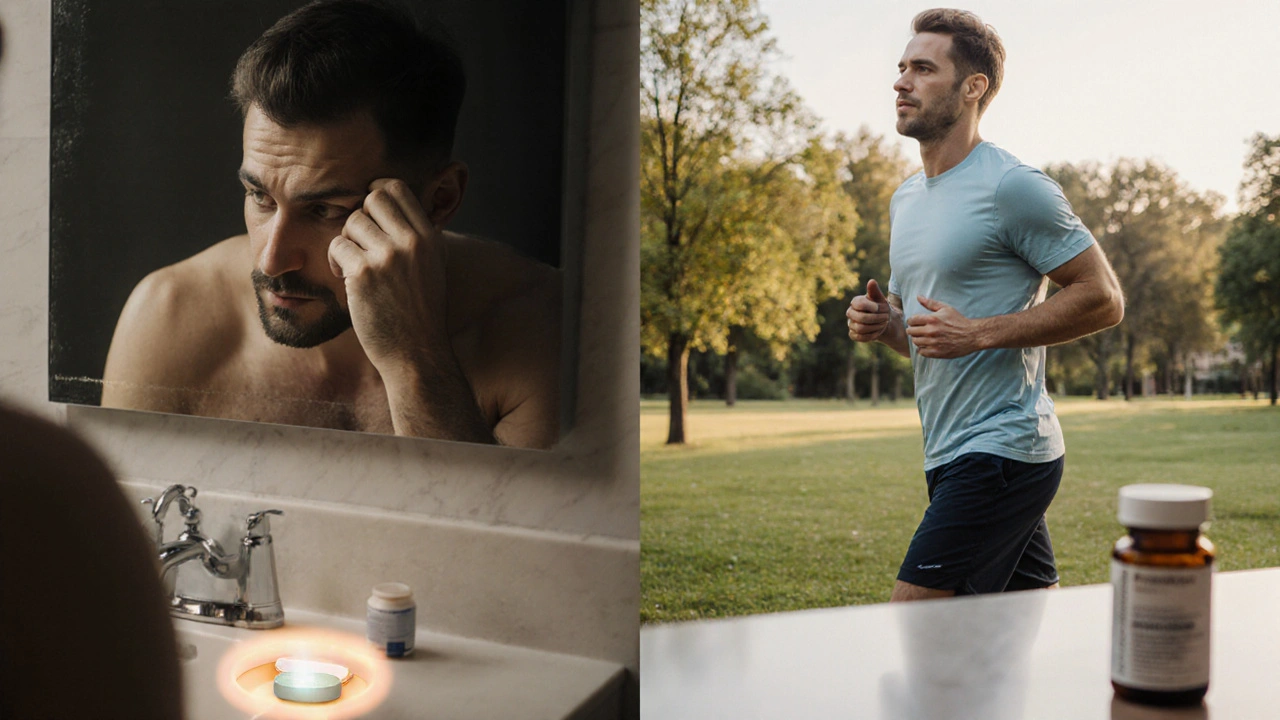Hair Loss Treatment Comparison Tool
Select your preferences to compare hair loss treatments:
7 5When it comes to tackling male pattern baldness, Finrest is a brand name for Finasteride, a synthetic 5‑alpha‑reductase typeII inhibitor taken orally, typically 1mg per day, that reduces dihydrotestosterone (DHT) levels in the scalp. It’s been the go‑to prescription for years, but a growing menu of alternatives - from other pills to topical solutions - gives men more choices. This guide lines up the most common options, weighs the science, side‑effect profiles, costs, and practicality, so you can decide which route fits your lifestyle.
Quick Take
- Finrest offers solid DHT reduction but can cause sexual side effects for a small % of users.
- Dutasteride works faster and blocks both typeI and II enzymes, yet it’s off‑label for hair loss in many countries.
- Topical Minoxidil 5% solution or foam applied twice daily is safe, inexpensive, but only maintains existing hair.
- Natural extracts like Saw Palmetto a plant‑based DHT blocker taken as 320mg daily have limited evidence and variable quality.
- Procedural options - Platelet‑Rich Plasma (PRP) autologous injections that stimulate follicles - are pricey but show promising growth in early studies.
How Finrest Works and What to Expect
Finrest targets the enzyme 5‑alpha‑reductase typeII, which converts testosterone into DHT. By cutting DHT production by roughly 70% in the scalp, it slows miniaturization of hair follicles. Most men notice a reduction in shedding within three months, and measurable regrowth often appears after six to twelve months.
Typical dosing is 1mg daily, taken with water. The drug is metabolized in the liver and excreted in urine. Because it’s systemic, it can affect other DHT‑dependent tissues - that’s why some users report decreased libido, erectile changes, or mood shifts. Studies suggest these side effects affect around 2‑4% of users and are usually reversible after discontinuation.
Top Prescription Alternatives
Two other prescription pills often get mentioned alongside Finrest:
- Dutasteride a dual‑type 5‑alpha‑reductase inhibitor (typeI+II) approved for benign prostatic hyperplasia. At 0.5mg daily, it can reduce scalp DHT by up to 90%. The deeper blockade can translate to faster hair gains, but sexual side effects appear slightly more often (≈5‑7%). It’s off‑label for alopecia in many regions, so insurance coverage may be limited.
- Spironolactone a potassium‑sparing diuretic that blocks androgen receptors. Primarily used in women, 100mg twice daily can reduce hair loss by lowering androgen signaling. Men risk feminizing effects (gynecomastia) and electrolyte imbalances, so it’s rarely prescribed to them.
Topical Options: Minoxidil and Beyond
Minoxidil originally a blood‑pressure medication repurposed as a vasodilator for hair follicles is the only over‑the‑counter (OTC) drug approved for androgenic alopecia. Applied twice a day, it prolongs the anagen phase and boosts follicular size. While it doesn’t lower DHT, it can add 10‑25% more hair density after six months.
Combination therapy-Finrest plus Minoxidil-is common; the duo attacks the problem from both hormonal and vascular angles, often delivering superior results.
Other topical agents include Ketoconazole shampoo 2% antifungal rinse that also reduces scalp DHT locally. Used twice weekly, it can complement systemic pills by cutting surface DHT without systemic exposure.

Natural & Herbal Alternatives
For men wary of prescription meds, several plant‑derived options claim to curb DHT:
- Saw Palmetto beta‑sitosterol‑rich berry extract sold in 320mg capsules. Small trials show about a 30% DHT reduction, but results vary widely.
- Pygeum africanum African plum bark extract used in traditional urology. Works by inhibiting 5‑alpha‑reductase activity in vitro; clinical data for hair loss are sparse.
- Green tea catechins (EGCG) also have modest enzyme‑blocking properties, but you’d need several cups daily to hit therapeutic levels.
Herbal products are appealing because of low systemic risk, yet they lack the rigorous FDA‑style testing that Finrest and dutasteride have.
Procedural & Advanced Therapies
When medication isn’t enough, clinics offer physical interventions:
- Platelet‑Rich Plasma (PRP) autologous blood concentrate injected into the scalp to release growth factors. Sessions cost $500‑$1500, spaced 4‑6 weeks apart. Meta‑analyses report an average hair‑density increase of 15‑30% after three sessions.
- Low‑Level Laser Therapy (LLLT) red‑light devices that stimulate cellular metabolism in follicles. Home‑use caps cost $200‑$800; studies suggest modest gains comparable to Minoxidil.
- Hair transplantation remains the most permanent solution, but it’s costly ($4‑$10k per graft) and not a direct alternative to DHT‑blocking drugs.
Side‑Effect Profile Comparison
| Agent | Primary Action | Common Side‑Effects | Serious Risks | Typical Cost (AU$) |
|---|---|---|---|---|
| Finrest (Finasteride) | 5‑α‑reductaseII inhibition | Reduced libido, erectile dysfunction (2‑4%) | Persistent sexual dysfunction (rare), depression | ~30/month (generic) |
| Dutasteride | 5‑α‑reductaseI+II inhibition | Similar sexual effects, slightly higher incidence (5‑7%) | Same as Finrest, off‑label regulatory issues | ~45/month |
| Minoxidil (topical) | Vasodilation, follicle stimulation | Scalp irritation, itching | Systemic hypotension (rare, with oral forms) | ~25 for 3‑month supply |
| Saw Palmetto (supplement) | Natural DHT blocker | Stomach upset, mild headache | Potential hormone interaction | ~40 for 60‑day supply |
| PRP Therapy | Growth‑factor injection | Temporary soreness, bruising | Infection (very rare) | ~1200 per session |
Choosing the Right Strategy for You
Think of your decision as a three‑step checklist:
- Assess severity and timeline. Early‑stage thinning (<30% density loss) often responds well to Finrest alone. Advanced stages may need a combo of finasteride, Minoxidil, and possibly PRP.
- Balance risk tolerance. If sexual side effects are a deal‑breaker, start with Minoxidil plus ketoconazole shampoo, then consider low‑dose dutasteride or herbal options.
- Factor budget and access. Prescription pills are cheap but need a doctor’s script. PRP and LLLT carry upfront costs but fewer daily commitments.
Many men find success with a two‑pronged approach: Finrest (or dutasteride) for hormonal control, plus Minoxidil for follicular support. Adding a once‑or‑twice‑weekly ketoconazole rinse further lowers scalp DHT without extra systemic exposure.
Potential Pitfalls to Avoid
- Stopping Finrest abruptly can trigger a rapid shedding phase-plan a taper or maintain a backup topical.
- Self‑prescribing high‑dose dutasteride without monitoring can amplify side effects.
- Choosing low‑quality herbal supplements may expose you to contaminants; stick with GMP‑certified brands.
- Expecting overnight miracles; even the best regimen needs 4-6months for visible results.

Frequently Asked Questions
Can I use Finrest and Minoxidil together?
Yes. The combination is common because Finrest lowers DHT while Minoxidil boosts follicle size. Use Minoxidil twice daily and take Finrest once each morning. Monitor scalp irritation and keep an eye on any systemic side effects.
Is dutasteride more effective than Finrest?
Dutasteride blocks both enzyme types, so it can cut scalp DHT up to 90% versus 70% for Finrest. Clinical trials show slightly faster hair regrowth, but the higher DHT suppression also raises the chance of sexual side effects. It’s off‑label for hair loss in many countries, so discuss it thoroughly with a dermatologist.
Do natural supplements like Saw Palmetto replace prescription pills?
Evidence for Saw Palmetto is modest; it may lower DHT by about 30% in some users. For mild thinning it can be an adjunct, but most men needing noticeable regrowth still rely on finasteride or dutasteride. Supplements are best seen as complementary, not a full substitute.
What are the costs of PRP versus daily medication?
A typical PRP series (3 sessions) runs around AU$3,600 in Australia. Finrest at AU$30 per month totals AU$360 per year. While PRP has a higher upfront price, some patients prefer the limited schedule and avoid daily pills. Cost‑effectiveness depends on personal preference and response.
Will I lose all hair if I stop Finrest?
If you stop Finrest, DHT levels rebound, and any hair gained during treatment typically sheds within 6‑12months. To maintain results, continue either Finrest or switch to a topical regimen like Minoxidil plus ketoconazole.





September 30, 2025 AT 16:26 PM
When we confront the dilemma of hair loss, we must weigh the ethical ramifications of pharmacological interference, for the pursuit of vanity should not eclipse a reverence for natural bodily processes.
October 1, 2025 AT 09:06 AM
Wow, this comparison tool is a game‑changer!!! 🎉 If you’re feeling hopeful about regaining some follicular glory, set those sliders and let the magic happen!!! You’ve got this!!
October 2, 2025 AT 01:46 AM
Esteemed readers, the nuanced distinctions among finasteride, dutasteride, and minoxidil merit a meticulous examination. It is paramount to consider both efficacy and tolerability while respecting individual dermatological contexts. 🌿📊
October 2, 2025 AT 18:26 PM
I've spent years reviewing dermatologic literature on androgenetic alopecia and I want to lay out the practical considerations. First, finasteride acts as a selective 5α‑reductase inhibitor and reduces DHT levels systemically. Second, its efficacy is well documented in clinical trials with a measurable increase in hair count after 12 months. Third, side effects such as sexual dysfunction, though infrequent, can be distressing for some patients. Fourth, minoxidil works as a topical vasodilator and its mechanism is less specific but still yields modest gains. Fifth, compliance tends to be higher with once‑daily oral dosing compared to twice‑daily topical applications. Sixth, cost considerations vary by region and insurance coverage. Seventh, dutasteride offers a broader inhibition of both type I and type II enzymes but carries a higher side effect burden. Eighth, patient preference should drive the selection process. Ninth, the interactive tool helps align individual tolerance thresholds with treatment potency. Tenth, it is advisable to monitor serum hormone levels when using systemic inhibitors. Eleventh, discontinuation can lead to rapid shedding, underscoring the need for a maintenance plan. Twelfth, combining therapies, such as adding low‑dose minoxidil to finasteride, may enhance outcomes. Thirteenth, lifestyle factors like nutrition and stress management also influence hair health. Fourteenth, ongoing research into platelet‑rich plasma and stem‑cell therapies holds promise for future alternatives. Fifteenth, ultimately a collaborative decision with a qualified dermatologist will yield the safest and most effective regimen.
October 3, 2025 AT 11:06 AM
Honestly, the data is clear-finasteride works, but you gotta watch out for those pesky side effects. If you ignore them, you’ll regret it later, no doubt.
October 4, 2025 AT 03:46 AM
Absolutely, Annette’s excitement is contagious! Just remember to double‑check the dosage recommendations before you hit “compare”.
October 4, 2025 AT 20:26 PM
Bernard’s comprehensive overview is commendable. 📚 It underscores the necessity of personalized treatment plans and vigilant follow‑up. 😊
October 5, 2025 AT 13:06 PM
While the tool offers valuable data, it’s crucial to recognize that individual genetics can override statistical averages, so clinicians should interpret results with nuance.
October 6, 2025 AT 05:46 AM
Oh sure, because everyone’s hair follicle calendar is totally predictable, right? 🙃
October 6, 2025 AT 22:26 PM
Let’s not forget that confidence isn’t solely hair‑dependent; fostering a supportive community can empower anyone navigating treatment choices.
October 7, 2025 AT 15:06 PM
Ugh, sure, talk about feelings while a bald head screams louder than words.
October 8, 2025 AT 07:46 AM
Great points all around! :) Keep the conversation going and share personal experiences when you can.
October 9, 2025 AT 00:26 AM
Actually, the pharmaceutical industry deliberately suppresses alternative data!!! They want you to stay dependent on costly prescriptions!!!
October 9, 2025 AT 17:06 PM
Clinical guidelines recommend baseline hormone assays before initiating systemic anti‑androgens.
October 10, 2025 AT 09:46 AM
Sticking to a regimen can be tough, but consistency often yields measurable improvements over time.
October 11, 2025 AT 02:26 AM
From a cultural standpoint, hair loss perception varies worldwide, influencing treatment acceptance.
October 11, 2025 AT 19:06 PM
Indeed, the phenotypic expression of androgenic alopecia necessitates a stratified therapeutic algorithm incorporating pharmaco‑kinetic profiling.
October 12, 2025 AT 11:46 AM
Many of these comparisons ignore long‑term safety data, which is a glaring oversight in current marketing narratives.
October 13, 2025 AT 04:26 AM
Personally, I prefer a minimalist approach, focusing on lifestyle adjustments before pharmacologic intervention.
October 13, 2025 AT 21:06 PM
Stay hopeful! 🌟